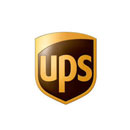
UPS
Atlanta, Georgia, U.S.
UPS, short for United Parcel Service, has a rich history that dates back to its founding in 1907 in Seattle, Washington, by James Casey. Initially named the American Messenger Company, it primarily focused on delivering packages and messages for local retailers and stores.
Founding:
James Casey and Claude Ryan established the company with $100 in capital and a few bicycles. The aim was to provide better delivery services than those available at the time. They recognized the need for efficient urban package delivery services in the rapidly growing American cities.Milestones:
1920s-1930s: The company expanded its services beyond Seattle, rebranded as United Parcel Service, and introduced innovative practices like consolidated shipments.
1953: UPS ventured into air services, launching its first air delivery service between major cities.
1975: UPS became the first package delivery company to offer Next-Day Air service.
1980s: Introducing advanced technology like DIAD (Delivery Information Acquisition Device) for real-time package tracking.
1999: UPS went public with an IPO, raising capital for further expansion and technological advancements.
2001: UPS expanded its global presence by acquiring Mail Boxes Etc., later rebranded as The UPS Store.
2012: UPS expanded its presence in Europe by acquiring TNT Express.
2020: UPS focused on sustainability initiatives, aiming for a more eco-friendly fleet and operations.
Evolution:
UPS evolved from a local messenger service into a global logistics giant, diversifying its services from ground delivery to air freight, supply chain management, and e-commerce solutions.Cultural Context:
The company's growth aligned with the rapid urbanization and industrialization of the United States. Its expansion mirrored the increasing demand for efficient and reliable shipping solutions in an evolving market.Positioning & Brand Values:
UPS positioned itself as a provider of reliable and efficient delivery services, emphasizing customer satisfaction, innovation, and a commitment to sustainability.Product Design:
The introduction of DIAD and other technological advancements streamlined package tracking and delivery, enhancing the customer experience.Visual Evolution:
The UPS logo and branding have remained relatively consistent, emphasizing the shield emblem and the brown color associated with the brand's iconic delivery trucks and uniforms.Successes and Challenges:
UPS's successes include its global expansion, technological innovations, and a strong brand presence. Challenges have included adapting to changing market demands, intense competition, and the costs of technological advancements.Controversies:
UPS has faced controversies related to labor disputes, environmental concerns regarding its fleet emissions, and occasional delivery issues, especially during peak seasons.Product Range:
UPS offers a wide range of services, including domestic and international shipping, freight transportation, logistics solutions, and supply chain management.Competitors in Different Segments:
Competitors include FedEx in the global shipping and logistics segment, as well as regional carriers and postal services in various countries.Revenue Streams & Financials:
UPS generates revenue from various sources, including package delivery services, freight forwarding, logistics, and e-commerce solutions. Its financial performance has been strong, with steady revenue growth over the years.- Other Brands
- Apple
- Microsoft
- Amazon
- Google
- Samsung
- Toyota
- Mercedes-Benz
- Coca-Cola
- Nike
- BMW
- McDonald’s
- Tesla
- Disney
- Louis Vuitton
- Cisco
- Instagram
- Adobe
- IBM
- Oracle
- SAP
- Facebook
- Chanel
- Hermes Paris
- Intel
- YouTube
- JP Morgan
- Honda
- American Express
- Ikea
- Accenture
- Allianz
- Hyundai
- UPS
- Gucci
- Pepsi
- Sony
- Visa
- Salesforce
- Netflix
- PayPal
- Mastercard
- Adidas
- ZARA
- AXA
- Audi
- airbnb
- Porsche
- Starbucks
- GE
- Volkswagen
- Ford
- Nescafe
- Siemens
- Goldman Sachs
- Pampers